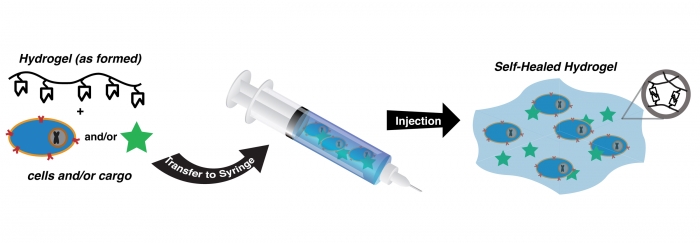 (Photo credit: Stanford Appel Lab)
(Photo credit: Stanford Appel Lab)
- Written by Stanford News
New nontoxic hydrogels developed by Stanford engineers could aid in food production and other applications
Hydrogels already form the absorbent layer in disposable diapers and the curve of soft contact lenses. A new process makes these materials useful for more applications, including wine-making and firefighting.
Hydrogels are gelatinous amalgams of cross-linked polymers that can absorb and hold large quantities of water. Their uses vary widely. Hydrogels derive their versatility from the fact that their basic ingredients can be tuned or formulated to provide varying degrees of stiffness and porosity. In the medical realm, for instance, some hydrogels serve as dressings to keep wounds moist and clean, while other formulations are used inside the body as sustained drug delivery systems. Now, a team led by Eric Appel, an assistant professor of materials science at Stanford, and doctoral candidate Anthony Yu describe how to make a new generation of hydrogels based on abundant natural materials. The simplicity of the process developed by the Stanford-led team should enable the production of hydrogels at industrial volumes, promising to break the current cost barrier and make these materials useful in a host of new applications in food and beverage manufacturing as well as other fields.
“When we mix the cellulose and silica together, we get a stable gel,” Appel said. “By altering the formulations, we can tune across an enormous range of mechanical properties. It’s not a knife-edge scenario – not a ‘gel’ or ‘no gel’ situation. Instead, you can get a whole continuum of gel states that can be useful for different applications.”
The research results are published in this article.
Read the full article at Stanford News.
Visible Legacy Comment
From the perspective of many years later, this technology could enable fundamental solutions for injectable drug delivery for vaccines and cancer immunotherapy.
Additional Info
-
Navigator:
 Explore the map in Navigator
Explore the map in Navigator - Widget:
- Caption: Stanford Eric Appel Lab
Related items
- The future of health care is in our cells
- Federal funding will help WSU professor develop technology to recover rare earth elements
- Unlocking the brain: Peptide-guided nanoparticles deliver mRNA to neurons
- Scientists Get to the Bottom of COVID’s Worst Pediatric Complication
- WSU-inspired national gene-editing task force begins work
